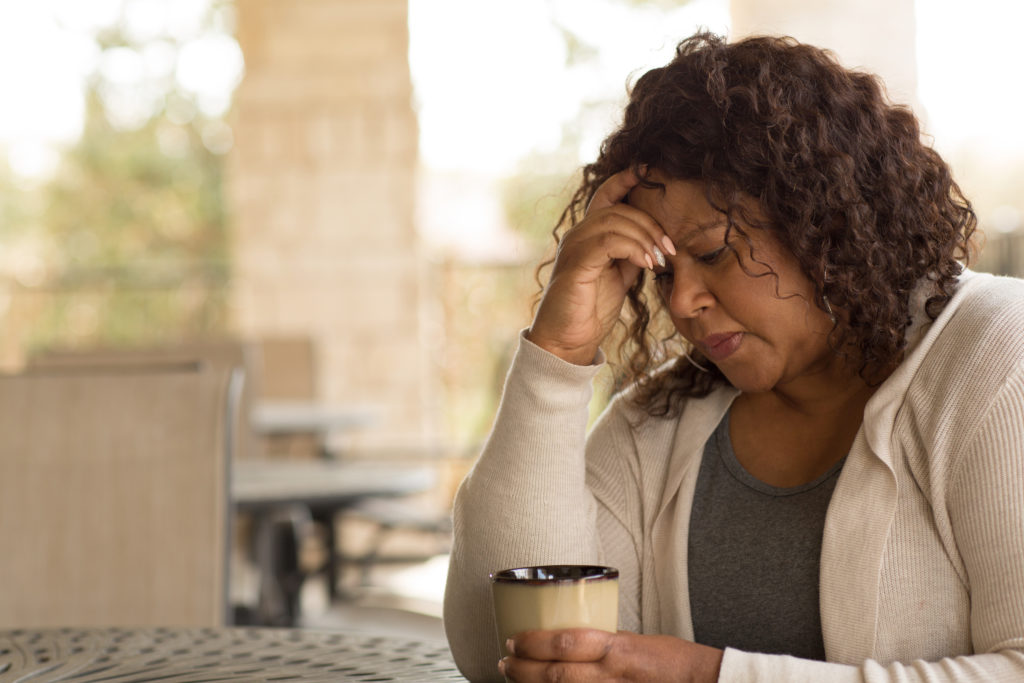When we hear that someone is depressed, we may assume that person is feeling extremely sad – perhaps crying all the time or even unable to leave the house.
And while this may be true, it’s not always the case. Depression has many other symptoms, and these can show up in different ways for different people.
Depression can appear during perimenopause, so it’s important to understand what it looks like at any age. Here’s how to recognize if you or someone you know may be experiencing depression.
What are the signs and symptoms of depression?
Though symptoms and severity vary, there are some key criteria that indicate someone may be suffering from depression, or major depressive disorder.
Lacking motivation to complete everyday tasks and responsibilities
We all have days where we don’t feel like cooking supper, cleaning our house, or going to work.
However, when this feeling continues – when a simple task seems insurmountable and wiping down the kitchen table feels like running a marathon – this could be a sign of something more serious.
If your energy levels and motivation remain low for more than a few days, it may be time to get checked out. Depression has a tendency to creep in slowly, so don’t discount these feelings as merely laziness or feeling tired.
Negative thoughts and a hopeless perspective
Because depression is a mood disorder, it’s known for creating cognitive distortions – otherwise known as warped thinking or intrusive thoughts. Those who are depressed are prone to negative thought patterns that can lead to a hopeless or pessimistic outlook on life.
For example, someone without depression might make a mistake and think, “Well, I learned from that. I’ll do better next time.” Whereas someone with depression may think, “I’m so stupid! I’ll never be good at anything.”
In other words, they may catastrophize mistakes or everyday events and turn them into character flaws. If not managed, these thoughts can spiral and create feelings of hopelessness, worthlessness, or even thoughts of self-harm or suicide.*
Difficulty focusing
With the increased stream of negative thoughts running through your head, you may find it hard to concentrate or focus on tasks. This can lead to reduced productivity at home, school, or work.
Losing interest in hobbies or activities you used to enjoy
In addition to not being able to focus, you may also find yourself losing interest in the things you used to enjoy, such as hobbies like reading or hanging out with friends. This lack of interest could lead to a sense of meaninglessness in life.
Intense emotions
Of course, a common intense emotion felt by those with depression is extreme sadness. But really, any emotion is vulnerable to the impact of depression.
Folks with depression may feel all emotions more deeply and struggle to control them. Men, in particular, are prone to irritability and expressing anger when depressed.
Changes in appetite and/or weight and sleeping patterns
A lack of interest in things also means a lack of interest in food/a reduced appetite. Conversely, some people with depression may overeat and experience an increase in appetite.
If you find yourself losing or gaining weight without trying, this could be a sign of depression.
You may also have trouble falling and staying asleep.
In addition to the signs above, it’s common for people with depression to also struggle with anxiety.
How do I know if I’m depressed?
Since some of the symptoms listed above can come and go, or may be the result of situational circumstances, it can be difficult to know if you’re experiencing depression or just feeling low.
Typically, to qualify as depression, you must experience the symptoms above for a period of two weeks or longer. If you’re still unsure, consult with your healthcare provider. They can complete an assessment, review your options, and refer you to a qualified therapist or other mental health professional if needed.
How do I cope with depression?
If you’ve been diagnosed with depression, there are many options available for you to start feeling better. Again, your healthcare provider can best determine a treatment plan, but there are a few things you can do on your own to manage ongoing symptoms:
- Practice cognitive behavioral therapy by replacing your negative thoughts with more realistic ones. You can try keeping a journal to refer back to later when the same thoughts arise. Eventually, this will become a habit and the negative thoughts may decrease over time.
- Seek support from family and friends.
- Exercise. Even light exercise – such as walking your dog – can be helpful.
- Remind yourself that your feelings are part of the disorder and are temporary.
The tips in this article are not meant to provide medical advice. Please consult your healthcare provider to discuss your symptoms and seek support.
*If you or someone you know is experiencing thoughts of self-harm or suicide, please contact the Suicide and Crisis Hotline at 988.
